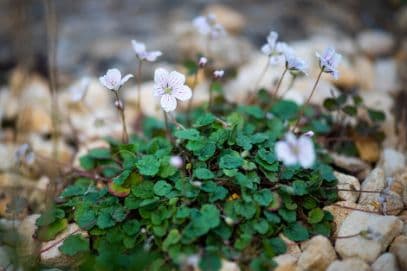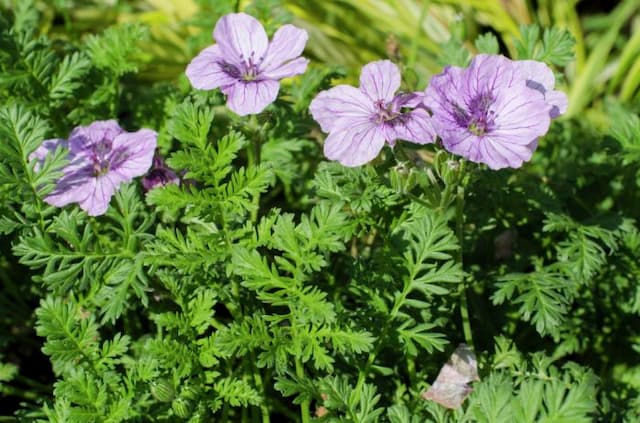Ardens geranium Pelargonium 'Ardens'

ABOUT
Pelargonium 'Ardens' is a distinctive plant known for its beautiful, eye-catching flowers and foliage. The flowers of this pelargonium are particularly striking, characterized by their radiant, scarlet hue with dark, almost black markings at the base of each petal. Their form is somewhat irregular, giving them a unique and exotic appearance, with petals that may appear slightly ruffled or crinkled. The foliage of the Pelargonium 'Ardens' is also attractive, with a deep green color that creates a lush backdrop for the vibrant blooms. The leaves are heart-shaped and have a slightly velvety texture, which adds to the sensual appeal of the plant. Additionally, the leaves may exhibit a slight zonal pattern, which is a darker area in the center that contrasts with the rest of the leaf. Overall, Pelargonium 'Ardens' has a bushy and branching growth habit that enables the plant to carry its magnificent blooms with ornamental grace. Although specific details about the plant's size are to be avoided, it's important to note that its growth habit and size allow for the various components of its appearance to come together in an appealing display that can catch the eye from a distance. The plant is a favorite among gardeners and flower enthusiasts for its stunning and distinctive appeal.
About this plant
 Names
NamesFamily
Geraniaceae.
Synonyms
Unfortunately, there are no widely recognized common names for Pelargonium 'Ardens'; it is usually referred to by its botanical name.
Common names
Pelargonium 'Ardens'
 Toxicity
ToxicityTo humans
The plant commonly known as "Horseshoe Geranium" is not generally considered toxic to humans. There is no widespread documentation of poisoning by ingesting this plant. However, as with any non-food plant, it is prudent to avoid ingestion since individual reactions can vary, and ingesting plant material can sometimes cause gastrointestinal discomfort or allergic reactions in sensitive individuals.
To pets
Horseshoe Geranium is also not generally considered highly toxic to pets. However, the ASPCA lists geraniums as potentially toxic to dogs and cats, causing symptoms such as vomiting, anorexia, depression, and dermatitis. It's always best to prevent your pets from eating plants, especially those that are not intended for consumption, to avoid the possibility of adverse reactions.
 Characteristics
CharacteristicsLife cycle
Perennials
Foliage type
Deciduous
Color of leaves
Green
Flower color
Red
Height
1-2 feet (30-60 cm)
Spread
1-2 feet (30-60 cm)
Plant type
Shrub
Hardiness zones
10
Native area
South Africa
Benefits
 General Benefits
General Benefits- Ornamental Appeal: Pelargonium 'Ardens' adds aesthetic value to gardens and indoor spaces with its unique and vibrant red-orange blossoms.
- Attracts Pollinators: Its flowers can attract beneficial pollinators like bees and butterflies, promoting biodiversity.
- Low Maintenance: Known for being drought-tolerant, requiring minimal watering and care once established.
- Adaptability: Can be grown in various conditions, from garden beds to containers, making it versatile for different gardening needs.
- Long Blooming Season: Often has a lengthy flowering period, providing color for extended periods of the year.
- Heritage Value: With its historical use in traditional gardens, it offers a classic and timeless appeal to modern landscapes.
- Fragrance: The foliage of some Pelargonium species is scented, which can add a pleasant aroma to the area it inhabits.
 Medical Properties
Medical PropertiesThis plant is not used for medical purposes.
 Air-purifying Qualities
Air-purifying QualitiesThis plant is not specifically known for air purifying qualities.
 Other Uses
Other Uses- Lucky charm: In some cultures, carrying a piece of the Geranium's stem is believed to attract good fortune and ward off negative energy.
- Natural dye: The Geranium 'Ardens' can be used to create a natural dye for fabrics, imparting a gentle hue.
- Arts and crafts: The striking flowers can be pressed and used in botanical art or to adorn homemade greeting cards.
- Flavoring: The leaves of this Geranium can be infused in sugar or syrups to add a unique flavor to desserts and teas.
- Perfumery: The aromatic oils of Geranium 'Ardens' can be used in homemade perfumes and scents.
- Companion planting: Gardeners sometimes plant Geraniums nearby to other plants to help repel pests with their strong scent.
- Ice cubes: Freeze the small flowers in ice cubes to create decorative elements for summery drinks.
- Garden border: The vibrant flowers and foliage can add an edge or a highlight to a garden border design.
- Photography: Geranium 'Ardens' offers a vibrant and attractive subject for macro and botanical photography.
- Educational use: Schools and educational programs use Geraniums to teach children about plant growth, pollination, and horticulture.
Interesting Facts
 Feng Shui
Feng ShuiThe Geranium is not used in Feng Shui practice.
 Zodiac Sign Compitability
Zodiac Sign CompitabilityThe Geranium is not used in astrology practice.
 Plant Symbolism
Plant Symbolism- Rarity: As a hybrid pelargonium, the 'Ardens' cultivar is less common than other geranium species, symbolizing uniqueness and the value of rare beauty.
- Endurance and Survival: This plant is known for its hardiness; it can survive in tough conditions, making it a symbol of resilience and the ability to persevere.
- Healing: Geraniums are often associated with health and healing, suggesting that Pelargonium 'Ardens' carries this symbolism and may represent recovery or the need for self-care.
- Friendship: Like many geraniums, the 'Ardens' cultivar can signify friendship and positive relationships, highlighting strong bonds and connections between people.
- Hidden Feelings: The Pelargonium 'Ardens', with its striking appearance, can be symbolic of hidden emotions or passions, hinting at depth and intensity that lies beneath the surface.
 Water
WaterThe Storksbill requires a moderate watering schedule, ensuring the soil is kept evenly moist but not waterlogged. During the active growth period in spring and summer, water the plant thoroughly when the top inch of soil feels dry, typically once a week, using approximately 16 ounces of water. In fall and winter, reduce watering to every other week, or when the soil has dried out more significantly, as growth slows. Always allow excess water to drain to prevent root rot.
 Light
LightStorksbill thrives best in bright, indirect sunlight. A spot that receives morning sunlight with some afternoon shade would be ideal. Avoid the intense midday sun, which can scorch the leaves. East-facing windows are typically a good location to achieve this balance of light exposure.
 Temperature
TemperatureStorksbill prefers temperatures between 55 and 70 degrees Fahrenheit for optimal growth and flowering. This plant can tolerate temperatures as low as 50 degrees Fahrenheit, but should not be subjected to temperatures below this, as cold damage can occur. It can handle heat better, but prolonged temperatures above 80 degrees Fahrenheit may stress the plant.
 Pruning
PruningPrune the Storksbill to encourage bushier growth and to remove any leggy or dead stems. Ideal pruning time is late winter or early spring before new growth begins. Snip off spent blooms and any yellowing leaves to maintain the plant's appearance and health. Pruning can be done every few months or as needed to shape the plant and control its size.
 Cleaning
CleaningAs needed
 Soil
SoilPelargonium 'Ardens', commonly known as Hardy Garden Geranium, thrives best in a soil mix consisting of equal parts peat, perlite, and pine bark. The ideal soil pH for the plant is between 6.0 and 7.0, slightly acidic to neutral.
 Repotting
RepottingHardy Garden Geraniums should be repotted every one to two years, or when the roots begin to crowd the pot, to ensure continued growth and health.
 Humidity & Misting
Humidity & MistingHardy Garden Geraniums prefer moderate humidity levels, between 40% to 60%, avoiding excessively dry or moist environments for optimal growth.
 Suitable locations
Suitable locationsIndoor
Ensure bright light, well-drained soil, and moderate watering for indoor Hardy Geraniums.
Outdoor
Place in light shade to full sun and use well-draining soil for outdoor Hardy Geraniums.
Hardiness zone
9-12 USDA
 Life cycle
Life cyclePelargonium 'Ardens', commonly known as Hybrid Hardy Geranium, begins its life cycle as a seed, which, when sown, germinates within a couple of weeks under appropriate temperature and moisture conditions. The seedling stage follows, with the development of the first true leaves and the establishment of a rudimentary root system. As it enters the vegetative stage, the plant experiences rapid growth of stems and foliage, during which time it requires ample sunlight and water to flourish. After a period of vegetative growth, typically in late spring to early summer, Pelargonium 'Ardens' progresses to the flowering stage, characterized by the emergence of its distinctive scarlet flowers with dark red veins. Once pollinated, typically via insects, the flowers develop into fruit, which are actually capsules containing seeds that can be dispersed by wind or animals. The plant then may enter a dormant phase during colder months, only to resume its growth cycle with the return of warmer weather, or it may perish depending on the climate, thus completing its life cycle.
 Propogation
PropogationPropogation time
Spring-Early Summer
Propogation: The Pelargonium 'Ardens', commonly known as Ardent Geranium, is frequently propagated through cuttings. This method is generally performed in late winter or early spring before the plant's active growth phase begins. To propagate by cuttings, a healthy non-flowering stem of about 4 to 6 inches (10 to 15 centimeters) long is selected. The lower leaves are removed, and the cut end is dipped into a rooting hormone to enhance root development. The cutting is then planted in a well-draining soil mix and kept under indirect sunlight with consistent moisture. The new plants typically root within a few weeks, after which they can be gradually acclimatized to more direct light and eventually repotted or planted out.




![Cranesbill [Blue Sunrise]](/_next/image?url=https%3A%2F%2Fplants-admin.emdemapps.com%2Fimages%2Fplants%2F%2Fimages%2F604b638d45948.png&w=640&q=75)




